|
Northern Baja California
Choice of Schedule
This year, family issues had the main word in the selection of the schedule. Both my daughters decided to produce another infant in the summer. Of course I was curious and so I waited for the birth of my two grandchildren and postponed the trip to the fall. Everything went well. At the end of July, Markéta was born and, exactly two weeks afterwards, Dominik. I enjoyed them at least for a little while before I could happily hit the road.
Rough Plan of the Route
I am flying to Tijuana in North-West Mexico, I was there back in 2006 when I cycled along the US West coast. The first part of the journey will be spent in Baja California, followed by a boat transfer to Central Mexico and I will continue somehow on to Mexico City. Then I would like to see the Mayan monuments on the Yucatán peninsula. I have a scheduled departure from Cancún at the end of November. That’s about all I know about the journey so far.
New Equipment
During the previous year’s Japanese trip, it transpired that my tent had already had its day. No wonder! Six long trips had worn it out and, needless to say, it had passed with honors, even in highly unfavorable weather. The 2.60-kg weight annoyed me. When traveling by bike, the weight of the load is one of the deciding factors (for fault-finders – I mean weight, not weights). I decided to buy the lightest, yet durable tent, of course, self-supporting, as it is sometimes necessary to pitch a tent somewhere on hard ground without the possibility of anchorage. I searched on the Internet and, after a lengthy decision-making process, chose the Big Sky Revolution 1P tent, weighing about 1.25 kg. The company advertised that it also delivered to the Czech Republic and so I ordered the tent on New Year’s Eve. The delivery time was up to 90 days, but I had no problem with that. In April, I started to enquire and got no response to my e-mail. I sent a fax – again no reply. Only when I sent a letter by snail mail, did I receive the reply that they would deliver the tent at the beginning of May. Nothing had arrived by the end of July, so I canceled it by snail mail. The only plus was that they did not deduct any payment from my payment card, so it cost me only time and a few cents in postage. After this quite unusual experience (the company is not interested in selling their $350 product?), I used a proven Czech company and purchased an AT tent from Jurka, which weighed less than 2 kg and was actually a bit smaller and an innovated version of my previous tent.
After the previous year’s troubles with the bags, I also addressed the issue of the front bags. Sport Arsenal makes only one type of waterproof bag, it is unnecessarily big and heavy, has no inside pockets, and after a day of cycling in the rain, is completely wet inside. I decided to go for the classics and, on German Amazon, bought the front bags from the Ortlieb company, which traditionally belong among the best on the market. Nobody was selling them in the Czech Republic at the time. To be precise, I found one seller, but he was unable to guarantee a delivery date or the selected color. I will have the Tioga bags, purchased in Australia, on the back. Their only fault is the undersized hinges on the pannier rack. The hinges snapped off one by one in Japan. I replaced them with hanging hooks from old Sport Arsenal bags and I believed it would do the trick.
I also replaced my mini Sony UMPC (650-g heavy laptop), the short battery endurance (about 2 hours) of which bothered me, as well as its miniature keyboard without diacritics and the perhaps very good, but small screen, which I had a problem sometimes reading with my worn-out eyes. When choosing a new laptop, I gave priority to the battery life. I bought the ASUS Eee Seashell 1005SE, advertised with a 14-hour battery life. Of course, I divided the assertion by two, but even seven hours in actual operation would be cool. However, I was to be pleasantly surprised. It seemed that, with my use of the laptop, the battery life could be about 10 hours. The weight of 1.3 kg was indeed a lot, but I had saved something by the lighter tent and something on the camera (I replaced the worn-out Minolta A2 with a Canon G10 purchased in Tokyo), so it worked out to about the same thing.
Flight to Tijuana
The flight lasted 21 hours and was as boring as usual. First of all, they charged me about 65 USD for the bike at the airport. I had known this in advance and did not have to worry too much about the weight, wrapping the bike up in a box, which provided better protection. In Paris, I just had time to move to another terminal and board the connecting flight. From Paris, I flew in a Boeing 777. It is a great aircraft, with seemingly more leg-room. The service on board was excellent. Besides the meals being served, there was also self-service available and one could help oneself to sandwiches, ice cream and various soft drinks. The night landing in Mexico City was impressive, the plane's descent right over the city was terrific. Then the problems started. The operators failed to provide the exit gangways and so, after half an hour of twiddling our thumbs, we were dragged to another entrance. So there was a one-hour delay to disembark, and for me this had become critical. My connecting flight was leaving in an hour and I had to go through Immigration, pick up my baggage, clear it through Customs, re-check it and then take a train to another terminal. But my luggage did not appear on the belt. I complained about it and they told me it was probably sent on directly to Tijuana, although both in Prague and on board, I was strictly warned about the necessity to declare it in Mexico City. It was already 20 minutes before my flight connection was to depart. When I arrived by train at Terminal 2, I already heard the last call for "Chiri Bina". I put on a spurt, the door closed immediately behind me and I was in the airplane.
Tijuana
At the Airport, I was happily reunited with my luggage. There were no luggage carts, so I hired a porter with a cart, who took my luggage to the security control. The control is performed by soldiers in camouflage fatigues with loaded guns. They opened my box with the bike and equipment, inspected everything thoroughly and palpated the suspicious parts. I had to explain what the spare parts for the bike were. Then I had it moved to the front of the Airport hall and at 1 a.m. (10 a.m. in Europe) I started to assemble the bike, under heavy surveillance and comments from the bored taxi drivers. After two hours I had finished, pushed it into the hall and caught some snatches of sleep until morning.
The route from the Airport was lined with hundreds of wooden crosses nailed on to the walls along the road. Four years ago, I had already visited this place and yet I was caught again by surprise at the ugliness of the city. Broken sidewalks, dirt, lots of cars, very poorly maintained shacks on the outskirts, with cars being repaired in front of many. In the center, an incredible number of pharmacies, pubs, brothels and souvenir shops. Military vehicles driving through the center, carrying soldiers with drawn automatic rifles were warily watching the bustle. In the course of the morning, I saw two military interventions, heard a distant explosion followed by a fire in the area across the river. There are two miniature parks near the center, in which I passed some of the time before I could go to my reserved hotel. I had been stupefied by the previous year’s merciless precision in Japan. Cheap Japanese business hotels accommodate you only after 3 p.m. It had happened that if I arrived in the pouring rain to claim my accommodation 15 minutes before 3 p.m., soaked through, they would enter my details and then say: "Come back at 3 p.m." In Mexico, obviously this was not the case. When they have a room, they accommodate you even at 7 a.m. at the normal rate. I somehow did not understand this on my first day there.
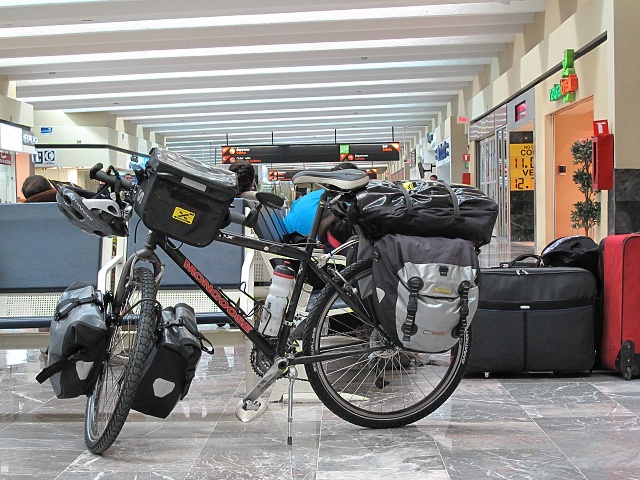
[Tijuana] After 3 a.m. I had my bike assembled and could park in the airport hall
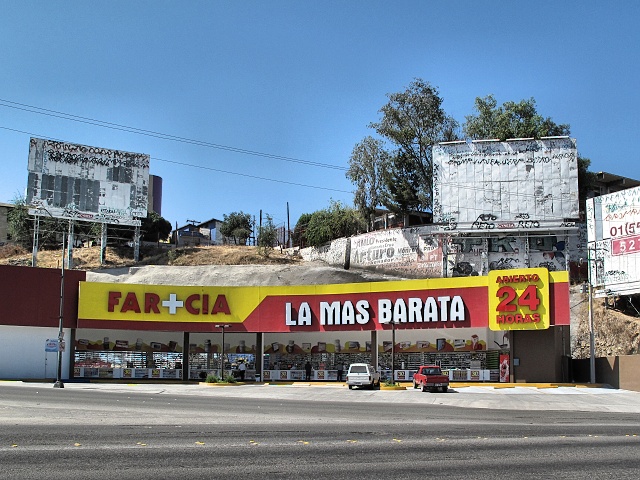
[Tijuana] A typical sight near the center, a huge pharmacy and billboards
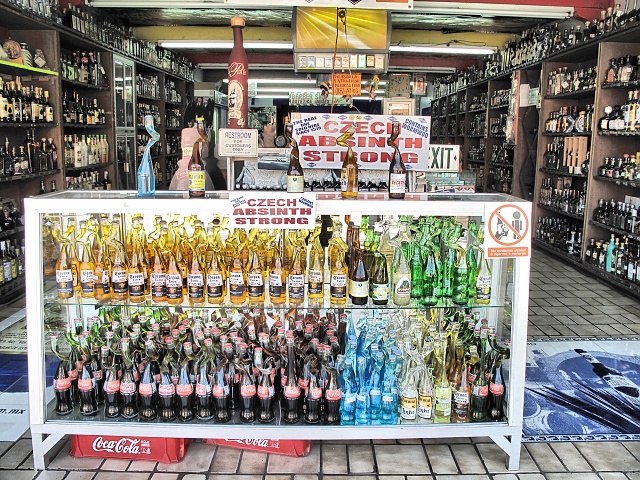
[Tijuana] Czech Absinthe is popular in Tijuana, it cannot be sold in most civilized countries
Bad Information, Bad Decision
Originally I had wanted to take a gasoline cooker, but I found information on the Internet that buying a gas cylinder for tourist cookers was not a problem in Mexico. So, to save weight, I took a gas cooker. However, I could not get hold of a gas cylinder, although I cycled all over Tijuana according to instructions from the tourist information center. There was not even an outdoor store in which to buy a gasoline cooker instead. Without a cooker, it would be no fun in desolate Baja California. We would see...
I Set Off
I slept for 10 hours and in the morning continued to try to locate a gas cylinder on the Internet, but without success. I learned that they might sell something like that in hardware stores, so I would watch out for them. I started off before noon. People stared at me as if at a madman, as the siesta had just begun. It was really terribly hot. After a few kilometers, I was sweated through. In addition, I was wearing a warning vest for heavy traffic and it does not have much ventilation either. On the next day, I placed the vest on the top bag on the rear carrier and so the problem was solved, it would serve the same purpose. The first 12 kilometers were all uphill. The quality of the road alternated, sometimes with shoulders, sometimes with verges, sometimes without anything. There was heavy traffic and some cars passed incredibly close to me. The drivers had probably never ridden a bike so did not know how a bike could swerve, or what the effect of a sudden gust of wind could be. The scenery was nothing spectacular and, even after arrival at the seaside at Rosarita, it did not improve significantly. The sea is almost inaccessible, everything is enclosed by new bungalows purchased especially by the Yankees (at least the advertising is aimed at them). There is no scenic beauty at all.
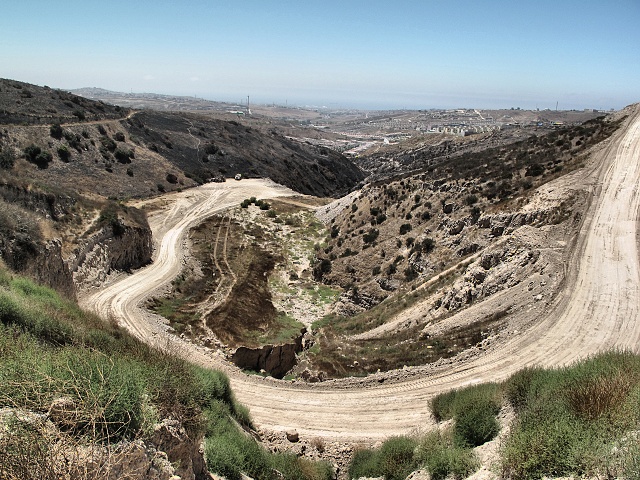
[Near Tijuana] A huge city of prefab houses is in the background
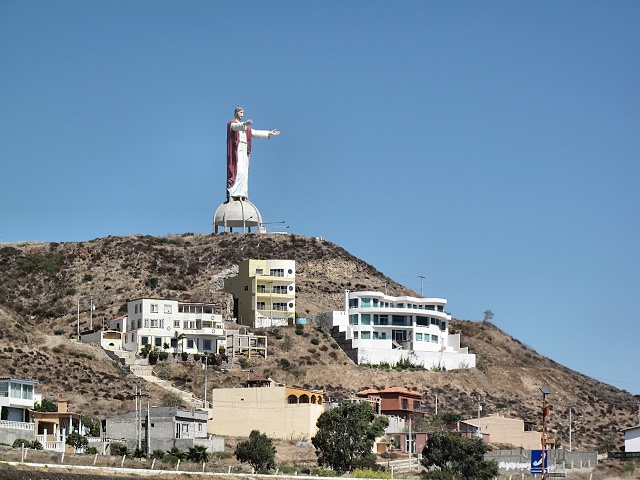
[Near Rosarito] Statue of Christ on the hill above the villas
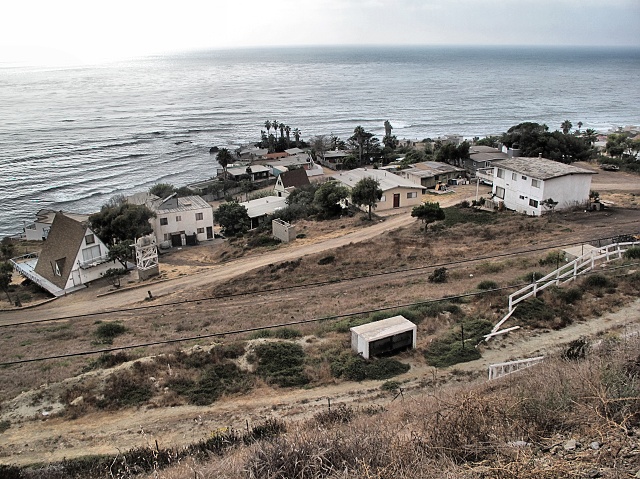
[Near Rosarito] The coast is mostly built-up with colonies of holiday bungalows and hotels, this was an exception
I dutifully toured all the hardware stores to try to find a gas cylinder. Eventually I was successful and purchased screw-on cylinders shaped like spray cans. The only problem—the cooker would tend to fall over due to the slim cylinder. But this was a trivial matter. I would somehow cope. So a big load was off my shoulders.
After 4 p.m., it became overcast, the clouds were low. So I cycled to the nearest camp for campers and trucks (the cost was about 7 USD). I was alone in the vast area, only some children crowded around my tent and the bike all the time. I had to watch to make sure they did not pinch anything. In the evening, the children left, to be replaced by two dogs. The problem was to find water for washing. Essentially it was only dripping from one tap. There were also outdoor showers under the tank, but without any running water. So I ate a few tortillas with cheese, drank one favorite Modelo Negro and at 7 p.m. crept into the new tent. I slept for almost 12 hours. The ocean hummed beautifully and I slept well through the sound of it. Perhaps I was compensating for the time difference and would soon be tuned in to the local time.
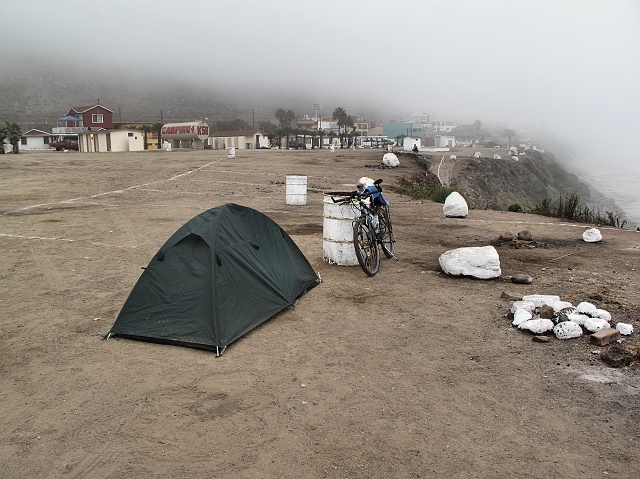
[Plaza Del Mar] I was alone in the entire large trailer campsite
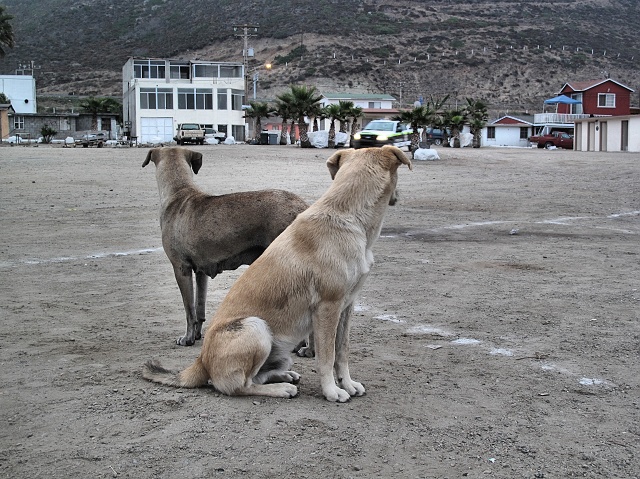
[Plaza Del Mar] I was guarded by two dogs in the camp, fortunately no problems with them, if I yelled loudly enough
Warming Up in the Hills
Two highways lead to Ensenada. One is a paid highway - marked 1D, leading directly there and with little elevation. But I had to take the other road, Highway 1, which is fortunately less frequented and curls between the hills, going up and down. But this was mild, compared to what was to come. In Ensenada, I crawled up to the motel, cycling directly up to the room. I walked through the city, which is a more civilized and happier copy of Tijuana, with especially the proximity of the sea being refreshing. I bought supplies and ended the evening with a decent dinner in the canteen (here known as a cantina).
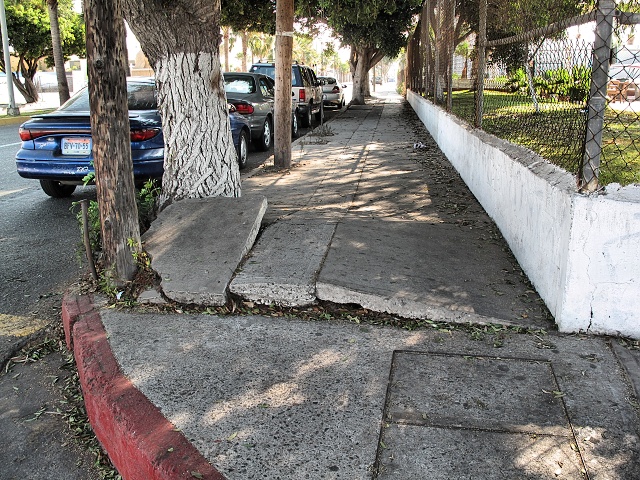
[Ensenada] Common condition of Mexican sidewalks
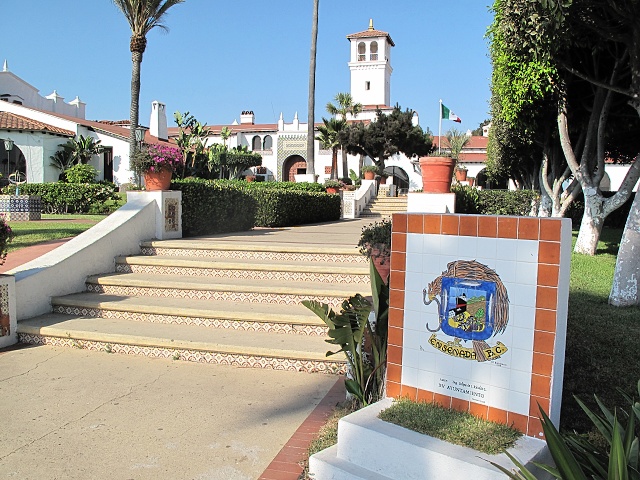
[Ensenada] Local cultural center
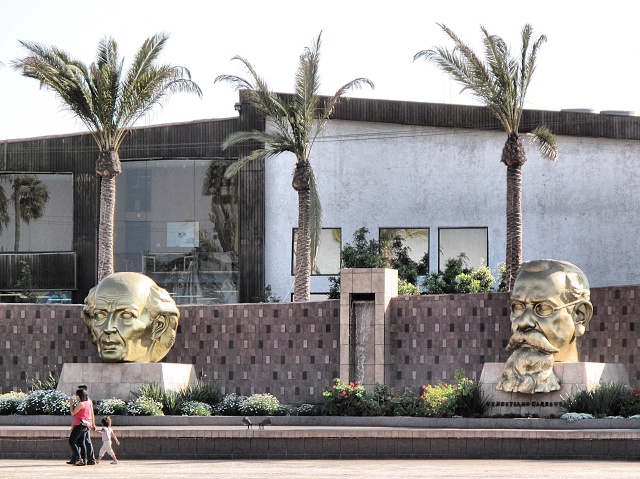
[Ensenada] Bronze busts of local potentates
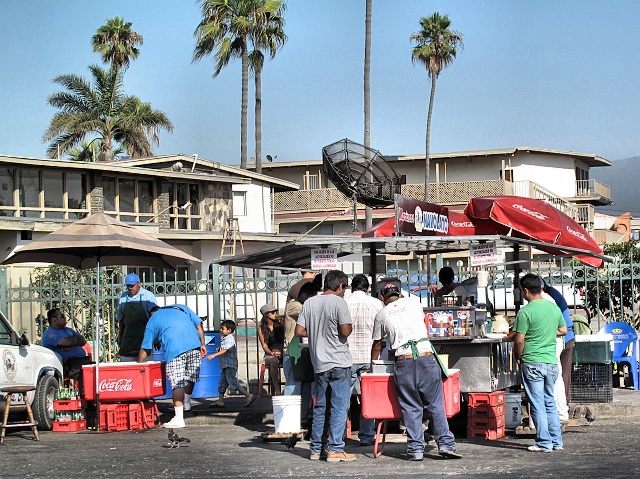
[Ensenada] Ensenada - very popular stalls, mostly focused on seafood, especially on large unknown-to-me shellfish.
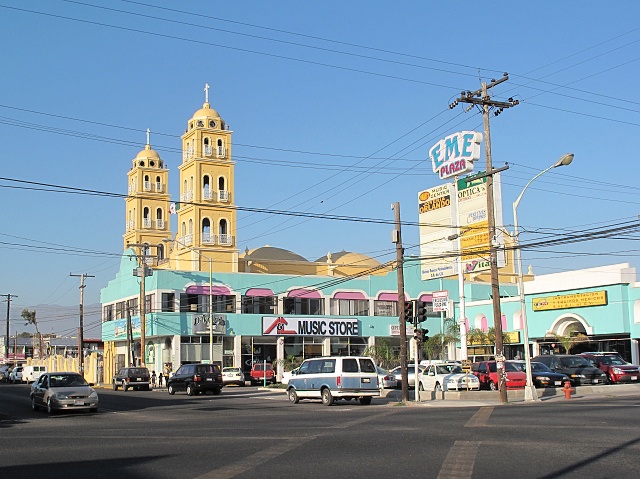
[Ensenada] The biggest church in town
Soldiers and the Combat against the Drug Mafia
Due to the better guarding of the U.S. borders, the volume of drugs smuggled into the United States has been reduced. This means less money for the drug Mafia and so Mafia gangs began to fight each other to get a bigger slice of the market. The Mafiosos began to kill each other in the towns, gun fights and assassinations were rampant. The Mexican government was not going to be reconciled to this. They took it seriously and deployed the army on a large scale. Therefore, not only in big cities like Tijuana, but also in smaller towns you would come across passing military patrols in large open-top jeeps, soldiers with big automatic rifles pointing in all directions, standing on the platform and watching the crowds. There were military checkpoints on the roads, protected on both sides by firing zones with machine guns, with every vehicle being inspected. I was only asked where I was going, routinely replying “a Cancún” . Once, as I was leaving the checkpoint, I heard the soldier calling to his colleagues: “Hey, the loco is going to Cancún.”
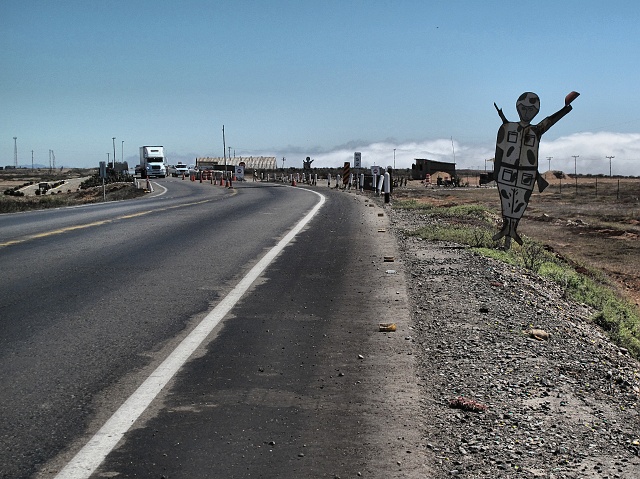
[El Consuelo] Arrival at a military control point, I obviously did not dare to take any photos!
People, Food
The natives mostly looked like happy fellows. They liked to chat, which was quite a problem after my few Spanish lessons. I had studied from a "teach-yourself" book, so I could say: cuaderno (notebook). However, drinking water, I only learned there—agua potable. Well, in the pub I was already able to order food, praise it, and ask for the bill. When it was possible to buy food, it was no use cooking. At least once a day I ate in a pub. I must say that the food got cheaper and better with the increasing distance from Tijuana. It was the best in small villages, where plump moms in aprons do not play at fancy cuisine, but cook honest food from locally sourced ingredients, without semi-finished products or flavorings. And of course, also her family, who actually live in the pub, eat it. The table linen was often what the house provided, plastic sheets over the tablecloths to prevent the pretty tablecloths from getting dirty. And I was not afraid to eat at street stalls, there were plenty of them. The hygiene was probably not the best, but perhaps this was the reason for the food being so delicious. At a stall in Ensenada, I had a taco with shrimp and prawns and it was incredibly delicious. Likewise, during the day I would stop at a village stand to eat, for example, a burrito which was always, without exception, great (and cheap). Speaking about money, the current rate was 14 pesos to 1 US dollar. A dinner with beer and tip cost less than 100 pesos, after which I was really stuffed. Tips given were approximately 10 to 15 percent of the price, as in the U.S.
The Real Baja California
The fun ended and the hard work began. I left Ensenada with stocks of food. The typical foggy morning was great for the ride, but the heat started already at 9.30 a.m. I put the nose shield on my glasses, which had been very useful in Australia. It was necessary, as the heat kept escalating and at around noon it was a murderous 57 degrees Celsius in the sun. I began to understand why people observed the siesta there. However, I tried to continue. On the hills, I almost melted. My heart rate was a maximum of 160 beats per minute, even when I was resting, the heart rate was 130 (normally it is about 60). I wanted to hide in the shade, but this was in short supply, almost no trees and a few shrubs would not save the day. I stood with my head in the shade of road signs to escape the unrelenting sunlight for at least a moment. The combination of steep hills and unbearable sun was simply deadly. I would have to adapt to the cycling time, start early in the morning and hide somewhere at lunchtime.
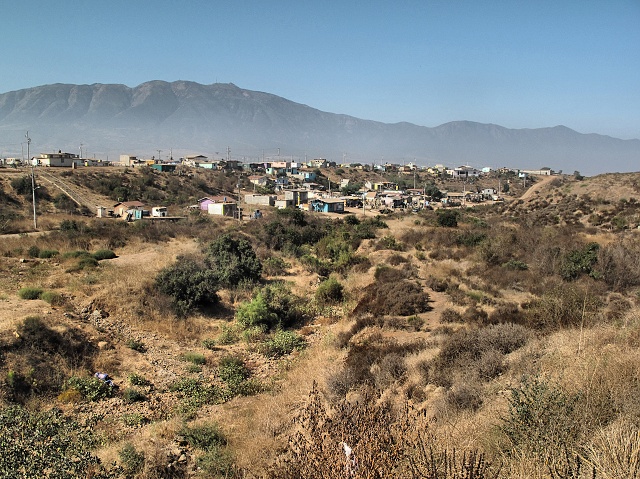
[Maneadero] View of part of the town below the imposing mountains
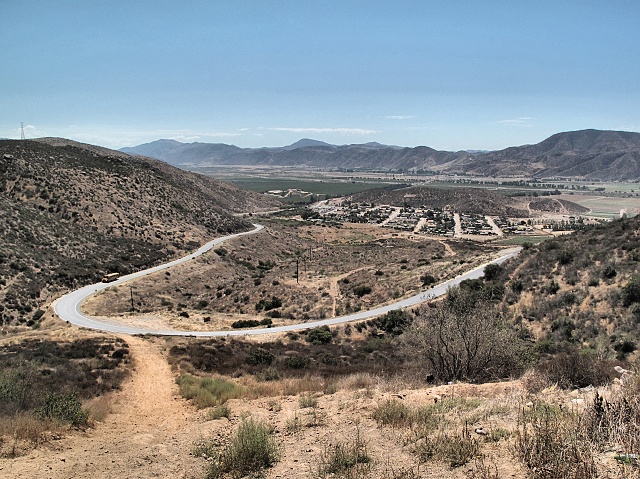
[Santo Tomas] The descent to Santo Tomas was fun, spiced up with a view of the town
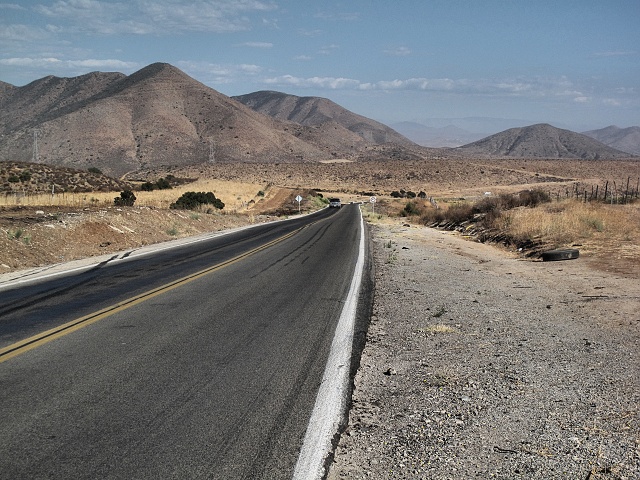
[San Vicente] The town is surrounded by picturesque mountains
The next day, I departed at 7 a.m. and it was fine until 10 a.m. The road was not too hilly, and cycling through to noon was no problem, so I covered 110 kilometers. It was not as hot as the previous day – a maximum of 50 C. Perhaps the Gatorade ionic drink had helped me. I had drunk it in the Australian tropics and it was readily available even in filthy country stores. Or it was the process of acclimatization and my well-tuned body was getting used to it.
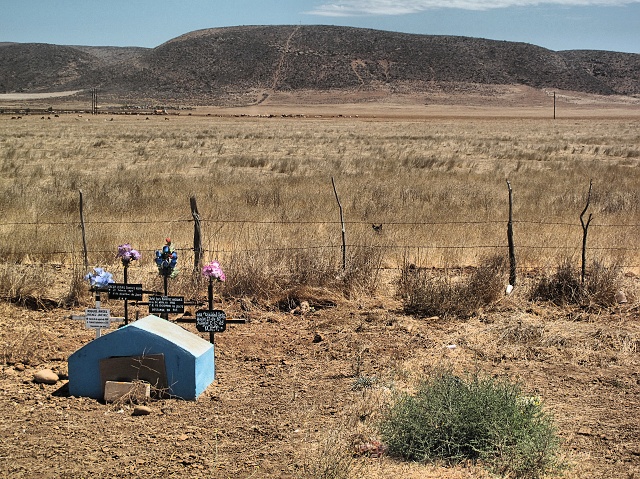
[Camalu] Crosses and small shrines are quite quite often seen at the roadside
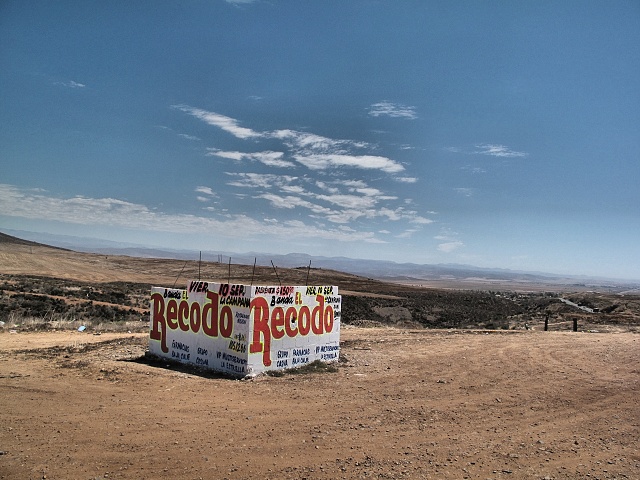
[Camalu] View of the countryside
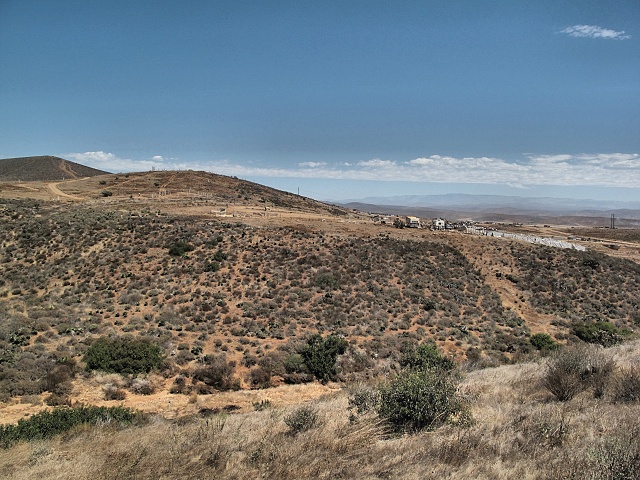
[Camalu] Hilly landscape
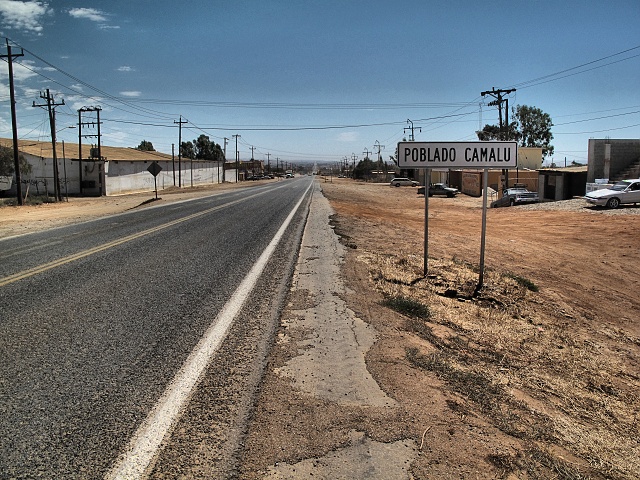
[Camalu] Typical town or village – asphalt road leads through the center, wide dusty lanes all around, lined with stores and restaurants; dusty side streets
The road was the same as elsewhere. When the road with heavy traffic had no verge, which usually was the case, I had to watch for trucks in the mirror. When a truck did not seem to be trying to avoid me, or when the traffic did not allow it, I quickly moved into the ditch and let the truck pass by. They sometimes honked and so I could make the same maneuver. Most of them thanked me with flashing lights. Many cars honked at me, people waved and occasionally called out something. What was unusual, most trucks coming from the opposite direction also greeted me with a honk.
To Rosario
From San Quintin, the road was basically flat. In addition, there was a mist from the sea, so cycling was pleasant. Along the road, sandstone cliffs appeared out of the mist, the rocks were disturbed by the water, which from time to time apparently flows from the mountains to the sea. Then came several kilometers of a cruel climb, of course, already above the fog and so in full sunshine. Surprisingly, even in the steepest sections, where I had to work hard to cycle up in the lowest gear, my heart rate did not exceed 120, and I felt fine. Apparently I was already acclimatized. At the top of the hill, there was a military checkpoint where soldiers carefully searched all the cars, but waved me on like an intrusive insect. And yet I would have liked to have shown them what I was carrying with me.
The beginning of the downhill ride resembled a ski slope, it was so steep. At the end of the slope, the famous Mama Espinosa restaurant awaited me on a bend. Cycling enthusiast, Victor Hugo Peralta Aguilar, had passionately recommended it to me in Ensenada (he had caught up with me on the road to give me his visiting card) and added a few good tips for cycling in Baja. If they are as good as his selection of restaurants, I have much to look forward to. At 3 p.m. I had a gigantic lobster burrito. It was fabulous and so hearty that I skipped dinner. In Rosario, I found a cheap motel, left my bags there and went to see the ruins of the Spanish Mission. It seemed to me strange that the only tourist attraction in the village had no marked route leading to it. If truth be told, there is even no proper road leading to the place, only a 5-kilometer dirt road of thick sand interrupted by one shallow ford across a brook. After I had viewed the few walls, I did my laundry, because this probably would not be possible in the next few days, due to sleeping out in the wilds.
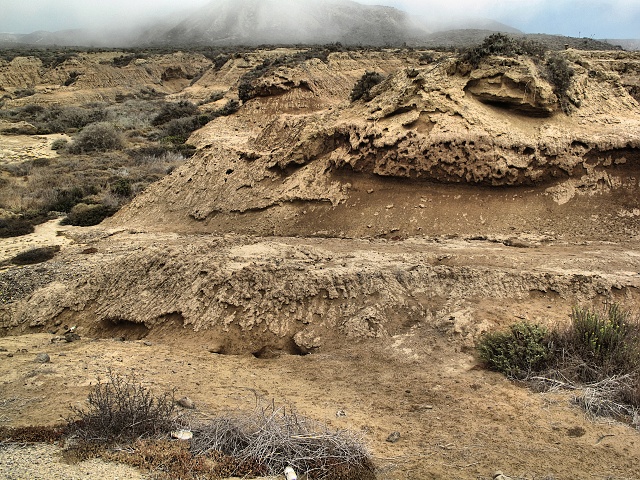
[El Consuelo] Eroded sandstone
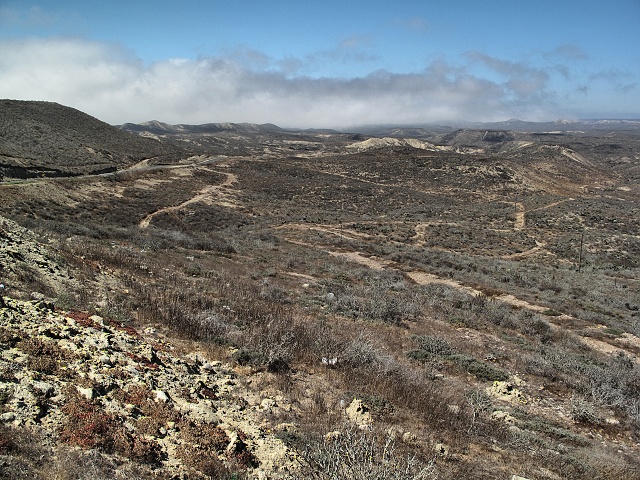
[El Consuelo] A view of the surrounding mountains from the top of the climb
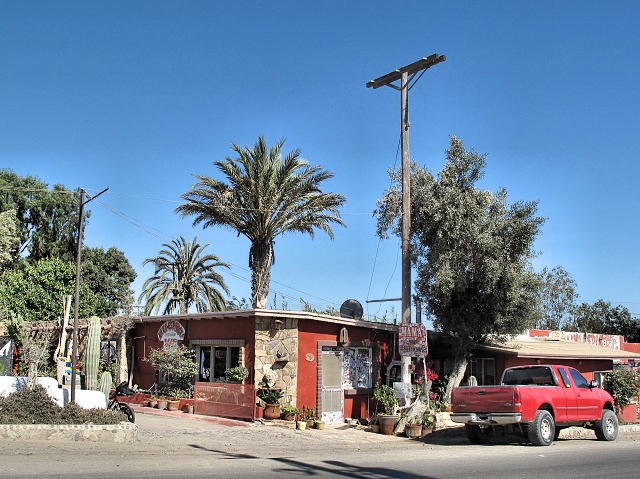
[El Rosario] The renowned Mama Espinosa fish restaurant, I had a lobster burrito and it was fabulous
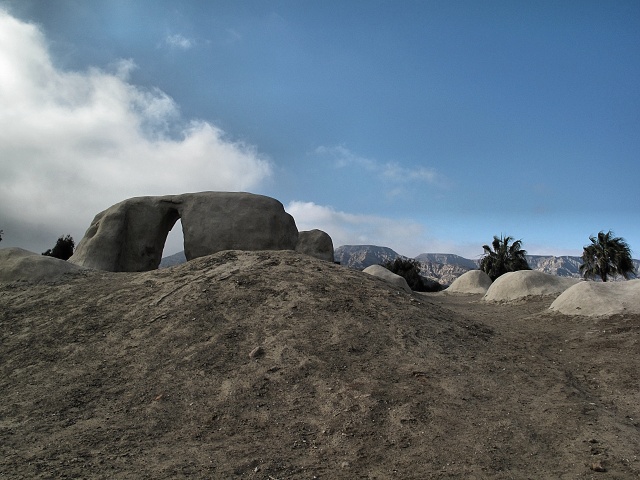
[El Rosario] Remnants of 1802 Spanish ecclesiastical Mission
Through the Barren Desert
The morning's cycle from Rosario to the plateau was quite grueling. The first cacti appeared, and then they accompanied me all the way to Guerrero Negro. Some were as tall as a four-story house. I have no idea what the huge desert plant lives on, where there is almost no rainfall. The cycling was breathtaking. There was little traffic, only a few cars per hour. The road twisted and made its way through the hills, so the visibility was mostly only a few hundred meters with a surprise around every corner: a new downhill road to the valley or, on the contrary, a climb up the next hill. Condors circled above my head. At first, I watched them carefully in case they were going to knock off my helmet, like the magpies had done in Australia. But they are very well behaved birds and such behavior is alien to them.
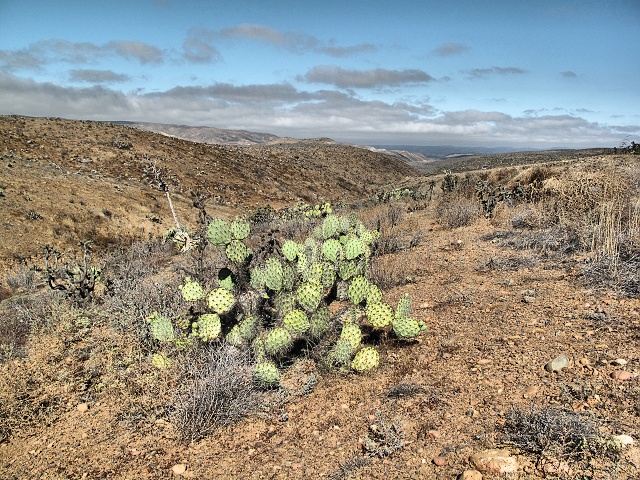
[Mesa Le Pitahaya] The first cacti appearing in the hills
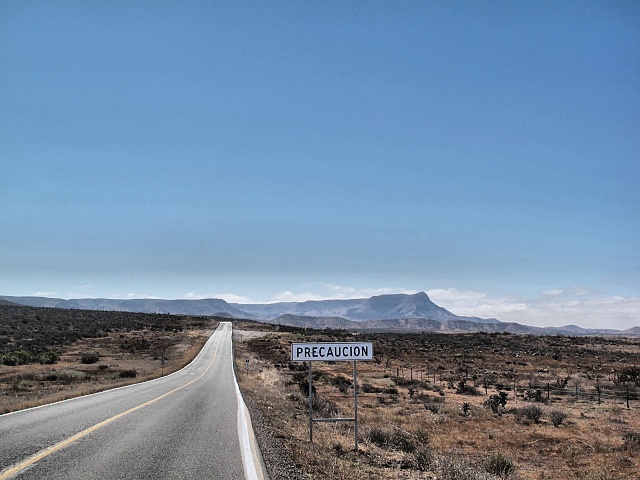
[Mesa Le Pitahaya] The road kept rising toward the mountains
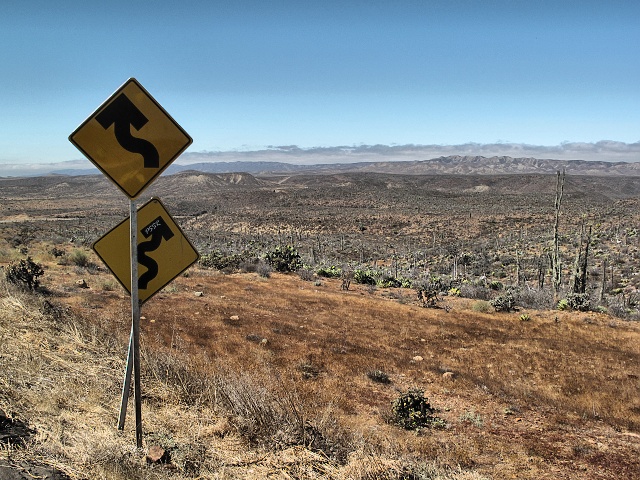
[Mesa Le Pitahaya] On the left is the road on which I arrived, the signs were inexplicably duplicated and hidden behind each other, for which I could find no reason!
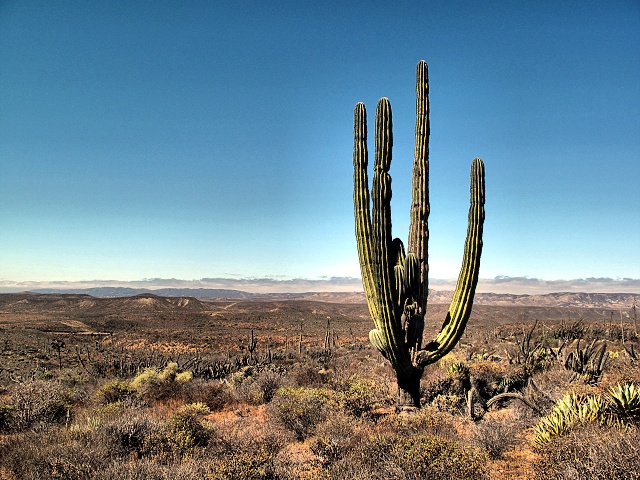
[Mesa Le Pitahaya] Some cacti were really giants, a 10-meter height was no exception
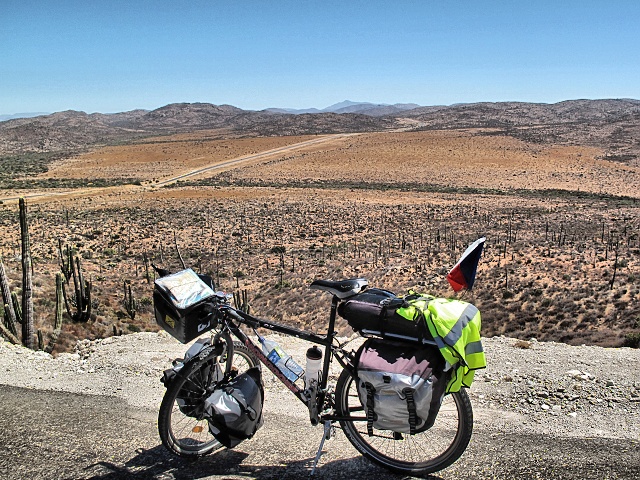
[Arerioso] The road crossed the edge of the basin, stretched along the bed, to rise up again on the opposite side
In Ensenada, Victor Aguilar had assured me that there would be a restaurant or store about every 40 kilometers. That may have been true a few years ago, when he traveled in the region. However, now I found a few closed pubs, even though they were marked on a special map that I had got in Tijuana. That is why I always tried to eat well after noon, so that it would last until breakfast the following day. Usually I did this in a “trailer park” where the truckers sleep in their cars. I could pitch my tent there too for a fee, but it was meaningless. Horrible toilets, showers without water, but the food was really good (maybe everything tasted great because cycling makes one hungry). So I had 10 liters of drinking water pumped into the bag (it was always free) and went to sleep in the desert. The water supply was adequate for the evening and morning wash. I had another 4 liters of bottled drinking water so as not to risk any problems. During the day, I drank almost 4 liters while cycling, yet I had a dry mouth and constant thirst all the time, despite the barrel of water splashing around in my belly. Mostly this was solved by drinking Gatorade during the day and a bucket of green tea in the evening before going to sleep.
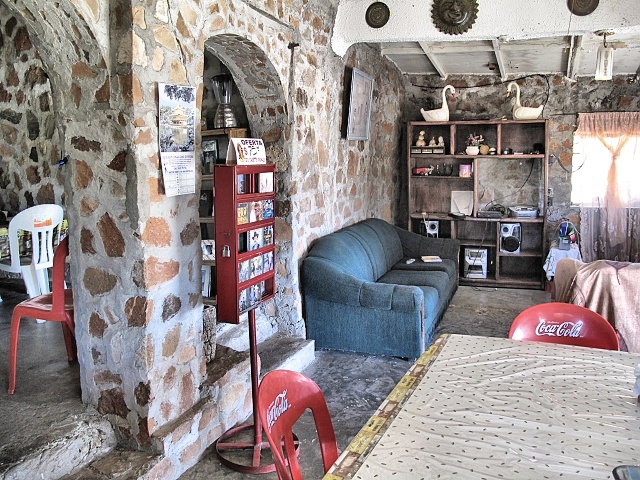
[Arerioso] The interior of the pub in the living quarters of the roadside ranch
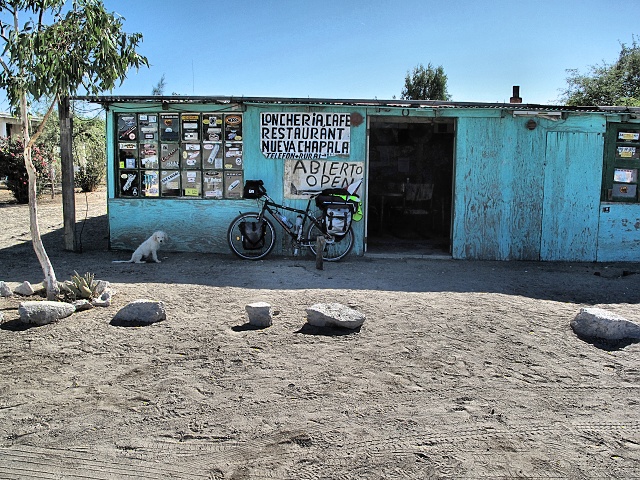
[Trailer Park in Laguna Chapa] I ate here, obtained 10 liters of water and went to sleep in the desert

[Turning to Bahia de Los Angeles] Toilets at a country restaurant
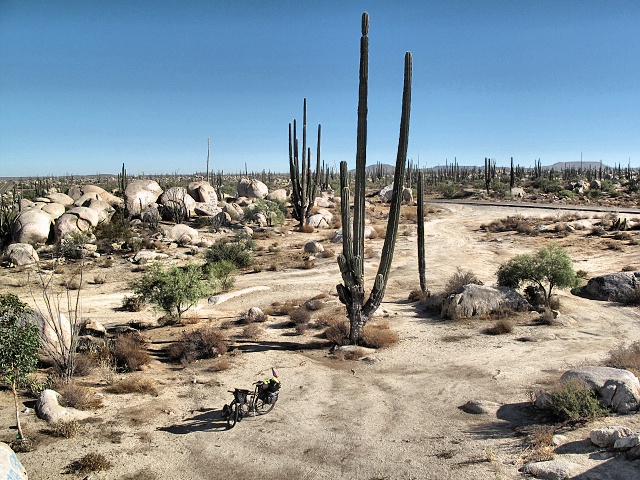
[Near Catavica] The size of the cacti are evident when compared with the bike
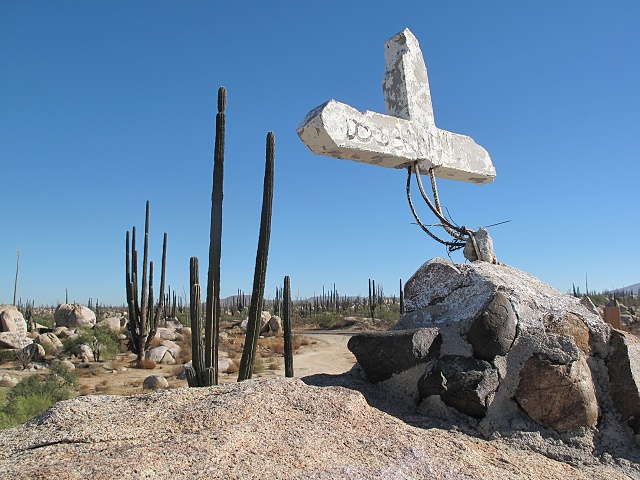
[Near Catavica] Cross of a rock chapel
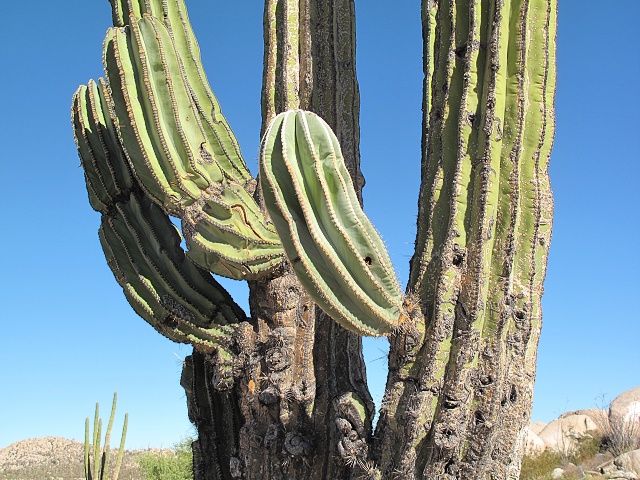
[Near Catavica] Impressive cacti
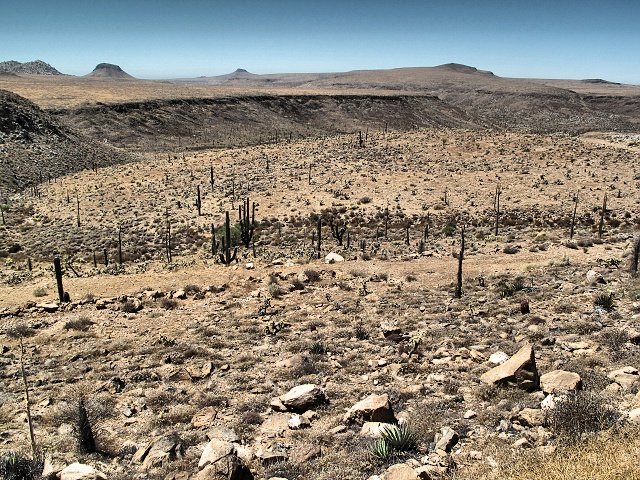
[San Ignacio] Terrain break with mountains in the background
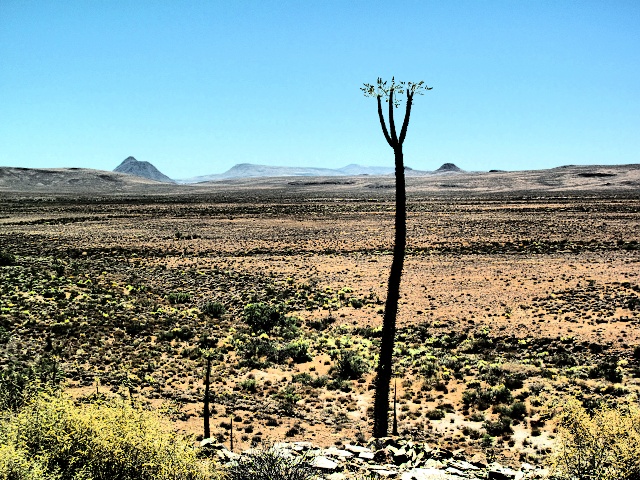
[San Ignacio] Road in another basin bed
Sleeping in the desert was amazing. There are no insects, it is surprisingly quiet. One must only watch out for rattlesnakes, scorpions and tarantulas. In particular, it is recommended in the morning to check one's shoes left outside the tent, in case the scorpions had moved in. In the evening, I made tea, sipped some red wine and observed the rapid transition of day into night. The sky color changed rapidly, the first stars appeared and in less than an hour the sky had turned black and the stars lit up the sky with unusual intensity. This is something we do not have a chance to see in our country, due to the light smog. At night, there was no heat. I covered myself with the sleeping bag, but did not zip myself into it. Surprisingly, there was a lot of dew in the morning. The tent was all wet and it was quite cold. I wore my jacket while cooking breakfast.
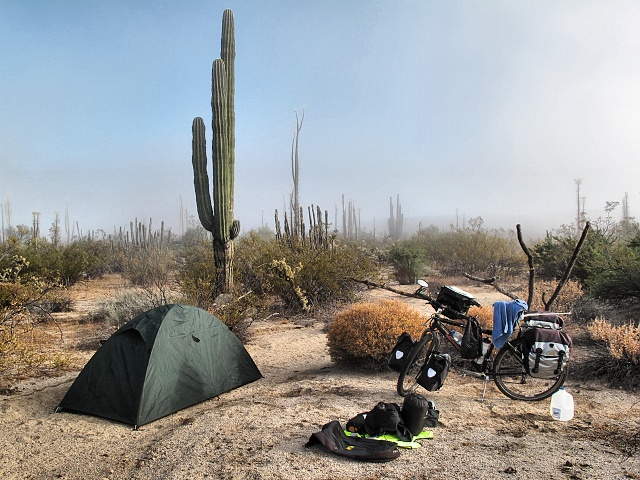
[Near Sonora] Lodging in the desert
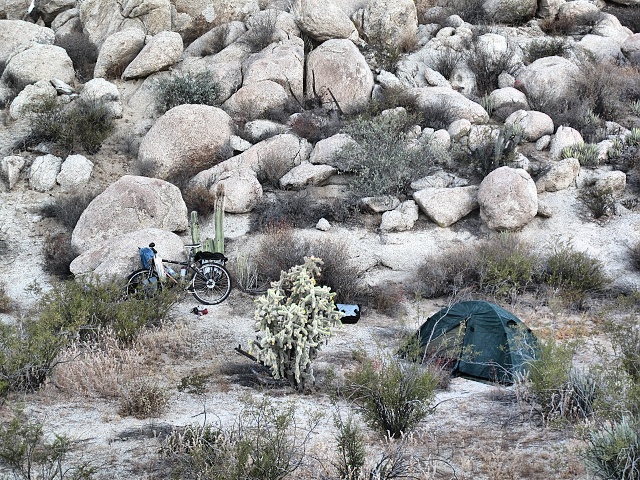
[Near El Crucero] Lodging among the rocks was fun, only a damn cactus punctured my front tire
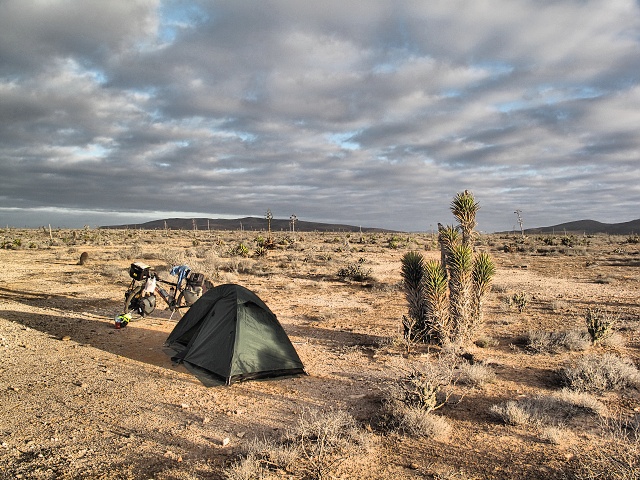
[San Angel] Another night in the desert, different every time, here I camped about 1 km from the road so as not to be seen
Goodbye Baja California North
Baja is administratively divided into two states –North and South. The borderline is the 28th parallel which I crossed before noon. I stayed in a motel in Guerrero Negro, which already belongs to Southern Baja. They are also one hour ahead (8 hours' difference to the Czech Republic). The city is famous for whale-watching. Whales arrive there for the winter from Alaska, their season being from December to April. I did my laundry in the local public laundromat, where they had the same washing machines as in the U.S., but not connected to water. So the lady showed me where to put my dirty clothes, poured in the washing powder and then took a hosepipe to fill the washing machine with water. I wondered how it would be washed – badly of course, but what do you expect for 18 pesos? Showered and in clean clothes, I went to the best local restaurant. I wanted a change from those country greasy spoons. The restaurant would rank among our former second price group, it was almost empty. I had fresh local fish, a plate of shellfish and some white wine. For nearly 15 USD, I had a great time there.
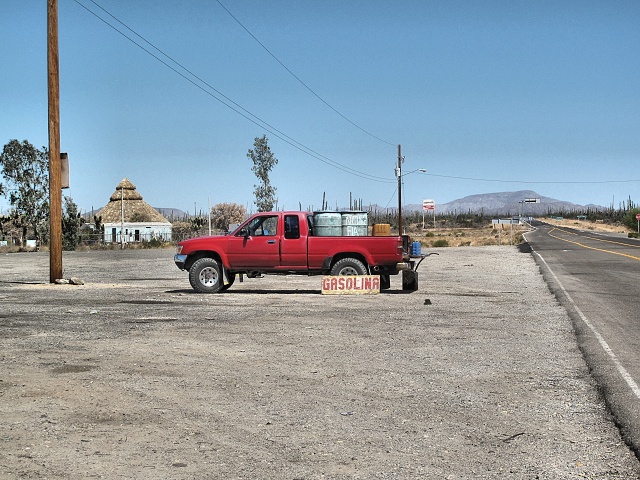
[Turning to Bahia de Los Angeles] No pump, gas is sold from cans and barrels
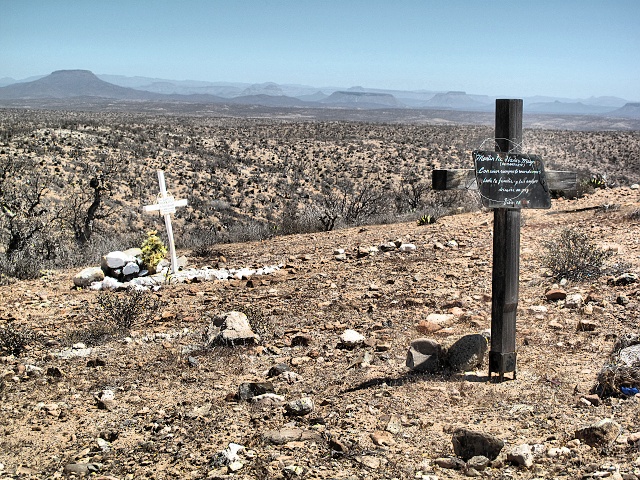
[Near Beccero] Again, more table mountains in the background
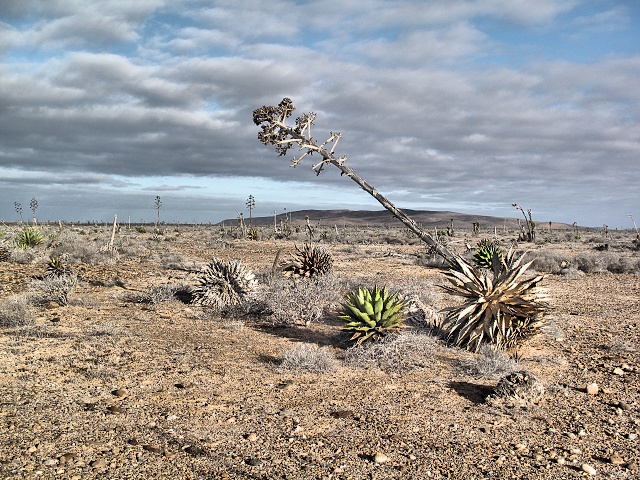
[San Angel] Morning clouds in the desert are also impressive, and almost the rule near the ocean
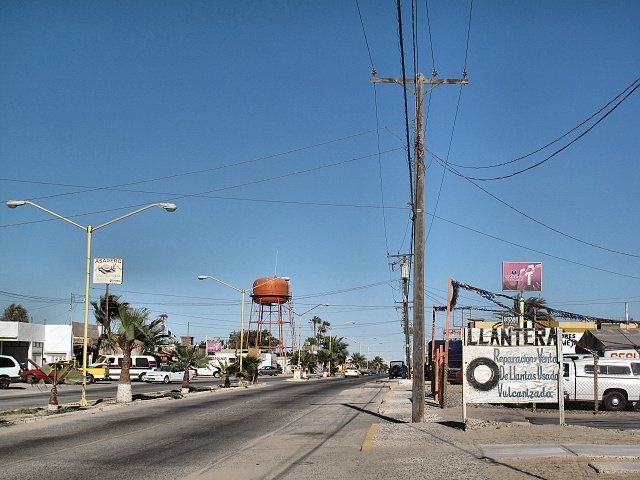
[Guerrero Negro] The center of a city of 10,000 inhabitants - nothing special
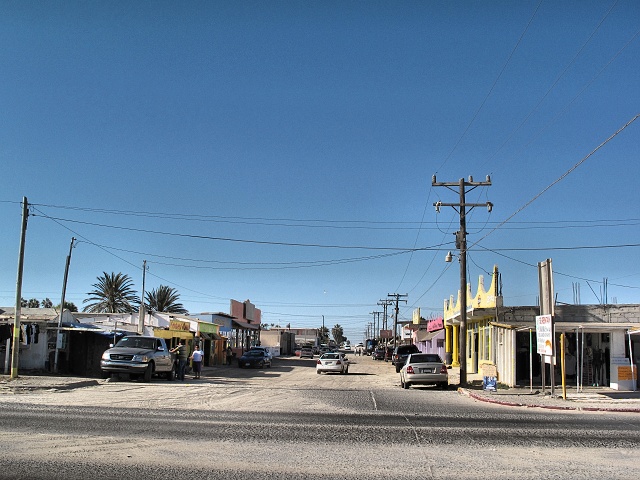
[Guerrero Negro] Only the main street is paved, side streets are dusty, covered in, quite literally, about 5 cm of fine dirty sand
Curiosities in Conclusion
In San Vicente, I asked the corpulent local cops about a camp which was marked on the map. They directed me to the 40-kilometer distant Santo Tomas from where I had just crawled across the mountains. It was an hour before dark, so they probably thought I was Lance Armstrong who would certainly make it on the 7-kg light bike with the support of a peloton. They were not too correct in that, but they excelled at something different. Three cars with guests arrived at the motel, followed shortly afterwards by the cops. They called the owner, made some threatening remarks and then opened the door of the police car, stepped back and nodded. The owner put a couple of banknotes on the seat, they nodded again and drove off. They had not taken any bribes, and nobody could blame them if people threw money into their car.
In the evening in San Quintin, I was hungry again and headed for the dark streets. It was Saturday and everybody was partying. Three slightly drunk guys came up to me, shook my hand, saying that we were friends and asking if I could give them a dollar. So I clapped the most active man on the back and told him “maòana, mi amigo, maòana”. It was clear to them, they began to laugh. Once again, we patted each other in a friendly manner and went our separate ways.




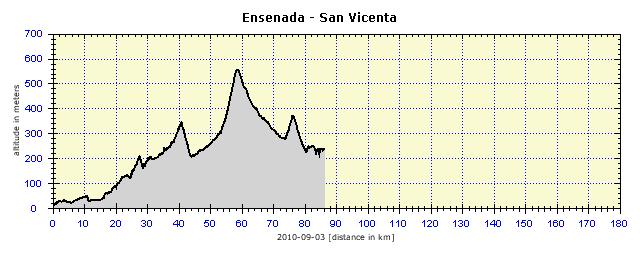


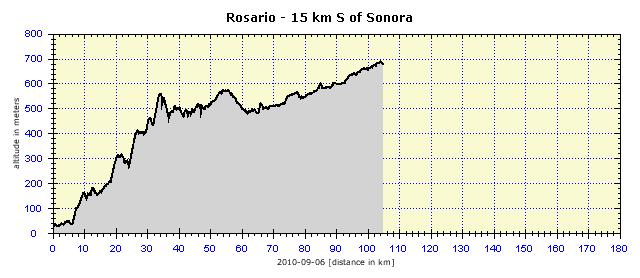

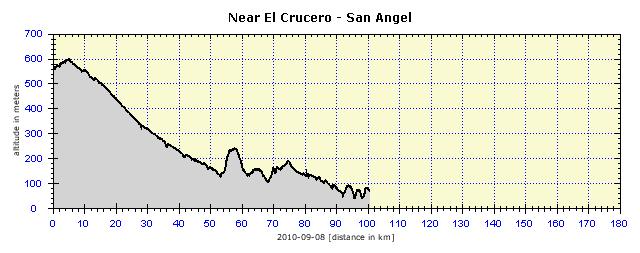

|
































































